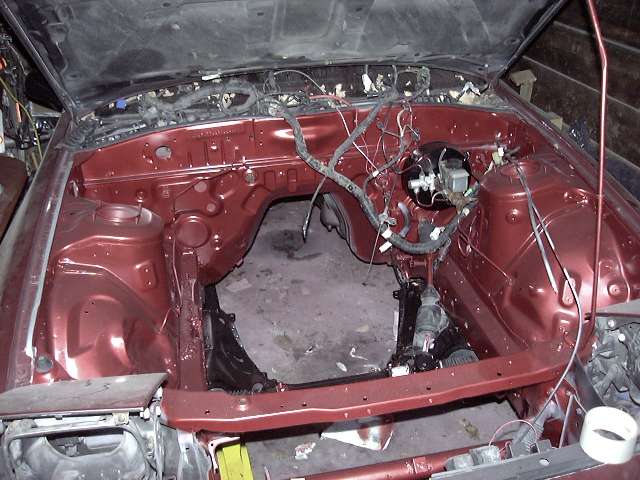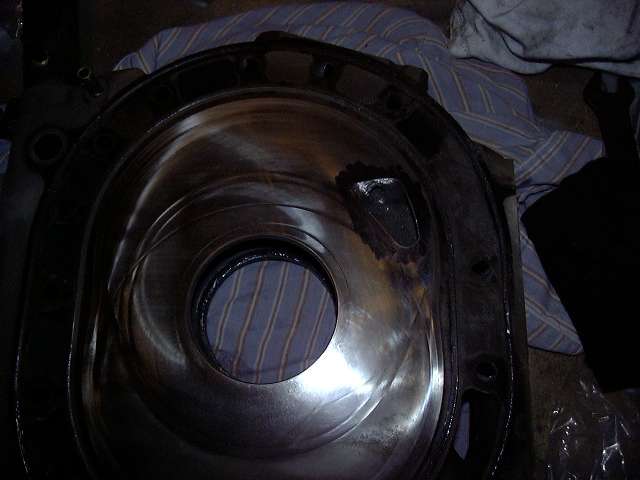| Home > RX-7 > My RX-7 > Project Tina > Project Tina, July 15th, 2004: Painting The Engine Bay, Porting The Engine, Shaving Lower Intake Manifold |
| Home > RX-7 > My RX-7 > Project Tina > Project Tina, July 15th, 2004: Painting The Engine Bay, Porting The Engine, Shaving Lower Intake Manifold |
It has been nearly two years since I last posted the status of project Tina (phase 2). The last update, posted in early 2003, contains the first part of the story. But to summarize, in Dec. 2002 I decided I would pull Tina's engine for a port and rebuild. After that, the project ballooned to include a quick engine bay painting, interior replacement, Microtech LT-8, bridgeport, big turbo, new exhaust, transmission rebuild, etc.
I honestly can't say that I put massive amounts of time into the project until early last summer. I had a busy time in my life, with multiple side projects, big meets (can you say Revolution?), and of course my day job. Because of this, work has been slow, with spurts of activity separated by periods of idle time. But anyway, in the past few months I have been working steadily and have some significant progress. So let's get to the pictures already...
When we last left off, the engine was disassembled on the bench. Basically, it sat like that until the fall of 2003, but I'm getting ahead of myself...

First, it was time to use the good spring weather to strip and paint the engine bay. The purpose of this paint job was not to make it look amazing, but to clean it up and make it roughly match the exterior paint of the car. 16 years of grime, grease, rust and general crap were removed with a wire brush, Castrol Super clean, and effort. 300 grit sandpaper was used to break the existing finish.
The bay was then masked with newspaper, primed and sprayed. Sorry about the lack of pictures of the primer, I just plain forgot to take them.
All painted up. For the record, the paint I used was MotoMaster Cherry Red metallic. The primer was Rust Check (this stuff is amazing).

Aside from the engine bay, all the components that are going back under the hood were also cleaned and detailed. This included the leading/trailing coils, charcoal canister, fuse box and bracket, brake booster, hood latch clutch master/slave and a few misc things. The brake master and brake lines will be highlighted black before the engine is dropped back in.
So in the fall of 2003, I finally got around to the actual engine. Here's a few of the stock NA exhaust ports.
First step is to remove the diffuser present in the NA exhaust ports. I could have just swapped in TII exhaust sleeves, but it's kind of a pain to remove the pins that hold them in and risk damaging the housings.
With the diffusers sent to hell where they belong, it was time to start the "real" porting. The first step was to obtain the templates. For the exhaust, I chose the Racing Beat "street" turbo template. It moves the port down to open it sooner, but keeps the top edge in the stock location to help combat overlap. Since no one makes a bridgeport 6-port template, I decided to pick up the Mazdatrix 6 port "street port" template and use it as a base.
The proper tools are very important. Using an underpowered tool is almost as bad as an overpowered one. The die grinder shown below is an electric unit, with a large 5A motor, 1/4" collet and a 28,000 RPM rating. Various grinding stones, paper rolls and mandrels were a hard thing to find locally, so I ordered the "Deluxe Porting Kit" from Standard Abrasives. It's meant for cylinder head porting, but the abrasives included obviously work with the castings in the rotary as well. The grinding stones are great for removing large amounts of cast metal quickly, while the sandpaper rolls just eat aluminum, and are wonderful for polishing and finish porting.
Most templates come as just an outline scribed on sheet metal. It is up to you to actually cut out the pattern. They say that this is to help you "practice" using a die grinder. Yeah, right. I was lazy so I just drilled out the rough shape.
And then finished it off with a paper sanding roll.
The dowel pin holes are used to locate the top of the template in relation to the exhaust port.
The template was taped in place...
And then the port shape scribed onto the housing. The black magic marker keeps the scribe line visible. Dykem or Machinest's blue is ideal for this, but try as I might I couldn't find any locally. Weird.
To port the exhausts, I started by using a grinding stone to remove the inner chromed surface down to the level of the scribe. It is very important to leave a bevel like the stock ports have. This avoids a "lip" which can catch the apex seal side. To bring down the aluminum, I used a paper sanding roll. It really works well for this purpose, and leaves an excellent finish. Not something I can say about the carbide bits that many people use. The one disadvantage about the paper rolls is that they can explode. You can see the two scuff marks above and blow the port which were caused by such an explosion. Luckily, they are nothing more then minor surface scuffs, and I don't worry about them.
I also took the sandpaper rolls to the inner surface of the port sleeves and smoothed them out considerably. This should help prevent carbon from sticking.
With the exhaust ports done, it was time to turn my attention to the intake ports. First, the template needed to be cut out. I started by roughly drilling out the area, then took down the aluminum to the lines with a cutting bit, after which I finished off with the paper rolls.
Since there are no 6 port bridge templates available, it was time to make one. The process is fairly simple; first, install a housing on top of an iron, then get a measurement of the width between the housing and the corner seal tracing mark on the iron. This is the width of the new "eyebrow" port. Remove the housing, and lay the template on the iron, then reinstall the housing. Trace a line following the housing. Remove the template, then use a compass to make the inner line by following the outer line. The gap of the compass is the previous width measurement. Close off the top and bottom where it looks "about right" based on the location of the runners and water jacket. The result is the tracing on the template below.
And here are the essential tools for making that template.
Time to work on the intermediate housing. You can see how much larger you can make the port. Actually, it can go just a little higher before you start to worry about the water jacket. The lower end can actually be tapered down as well, but here you run into the water jacket very quickly. Note that the port is not moved out at all, so it doesn't open that much sooner.

Primary ports almost done. At this point, they just need a little touch up and polishing. Also, the runners need to be ported (remove the casting flash, smooth the transition to the port, and make them a wee bit bigger). The rough work was done with a large grinding stone, then finished off with a delicate tiny stone. Polishing and smoothing was done with the paper rolls.

So after the primaries, I got a little bored with the porting and decided to attack the lower intake manifold. Since I no longer have the ACV (it interferes with the turbo), nor any of the other emissions equipment (the Microtech ECU doesn't run it) there is simply no need for the bulk of the lower intake. And frankly, block off plates and the associated solutions are just hacks. Clearance between the turbo and NA lower intake is also very tight, so I decided to simply cut off all the unneeded parts of the manifold. It is amazing how much of the lower intake is just empty space.
